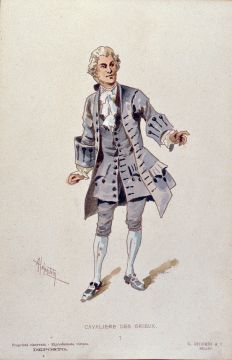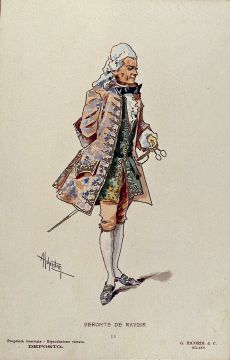Puccini A to Z – L as in Manon Lescaut

L as in Manon Lescaut
Manon Lescaut was Puccini’s first successful opera: inspired by the novel “Histoire du chevalier Des Grieux et de Manon Lescaut” by Antoine François Prévost, the opera was composed between 1889 and 1892. The libretto went under several reviews and librettists: Marco Praga, Domenico Oliva, Ruggero Leoncavallo and finally Luigi Illica, who mostly worked on the beginning of the second act and on the whole third act. The libretto was published by Ricordi without the name of its authors.
Puccini had his own ideas and, already in the early stages of his career, was very demanding. His high sense of theater made him change part of the dramatic arc and remove completely one act, entirely focused on the love nest of the two lovers, originally placed between the current first and second act.
Genesys
Puccini was fresh of an unsuccessful production of Edgar, whose libretto by Ferdinando Fontana was judged by many not up to par. While reworking on some parts of Edgar, Puccini was already thinking about his next opera: Tosca. However, Ricordi had already signed in July 1889 Praga and Oliva to write a libretto based on the Prévost’s novel and Tosca would have had to be put off for another decade, after two other operas, Manon Lescaut and La Bohème. Curiously, the subject had been pitched to Puccini some four years earlier by Fontana himself, but Puccini did not seem interested in it at the time.
Busy with the rework of Edgar and with a reduction of Wagner’s “Die Meistersinger von Nürnberg” (commissioned by Ricordi), Puccini confidently enough takes on the new adventure of what would become his first mature opera. In January 1890, Puccini writes the small string quartet “Crisantemi” (chrysanthemums) dedicated to the memory of Amedeo of Savoia, Duke of Aosta: the music from this quartet became an integral part of Manon Lescaut.



While Puccini was working on the music and orchestration of act I, the librettists were working on the other parts of the opera. But when the composer showed high disappointment for their work, Marco Praga, quite successful at the time, decided to pull out. Ricordi at this point called Leoncavallo, not yet famous as a composer. The work proceeded at a faster pace for some time but it came to a stop again in the second act. At which point Illica was called to intervene and, with Puccini’s suggestion of cutting an entire act and grouping other scenes, the libretto was finally completed.
Manon Lescaut, initially destined to the Teatro alla Scala, debuted at the Teatro Regio in Turin on February 1st, 1893. The subject had already interested two French composers: Daniel Auber and Jules Massenet. Puccini didn’t care. When Marco Praga pointed out that he would have had to stand a comparison, especially with the highly successful Massenet, Puccini answered:
“He’ll feel it the French way, with powder and minuets; I will feel it the Italian way, with desperate passion”.
Act I
A large square at the door of Paris, at Amiens
Near a tavern, students, bourgeois, and girls are joking about themes of love and youth. One of the students, Renato Des Grieux, boasts of his indifference to love (“L’amor? Questa tragedia, ovver commedia, io non conosco!“)
A carriage arrives, from which Manon Lescaut, a girl destined for monastic life, and her brother get out. Manon’s brother in the libretto is only called by surname: Lescaut. When Des Grieux sees Manon, it’s love at first sight. As soon as the girl remains alone, he approaches her and, when she returns to her brother, he manages to get a new date with her.
Meanwhile, Lescaut concocts his sister’s abduction. In this way, she will become the lover of Geronte, a wealthy banker, and he will share her luxurious life. But one of the students, Edmondo, hears the dialogue, informs his friend Des Grieux and organizes a countermove: Renato will kidnap Manon, beating old Geronte. Des Grieux manages to convince Manon to escape with him, and as students salute the carriage of the two lovers, Geronte plans his revenge. Lescaut, on the other hand, is sure that his sister will not put up long with a modest life.
Donna non vidi mai
Act II
In Paris
We are in the living room of Geronte’s house. As predicted, the idyll lasted very little and Manon went back to her brother to become the banker’s lover. We see her looking at herself in the mirror as she prepares for a reception, during which she will have to perform in dance and singing. However, the girl begins to get bored and to feel nostalgia for Des Grieux, so much that her brother, in order to prevent the situation from collapsing, decides to call Des Grieux to the palace.
The reception is over, Manon is alone. Des Grieux breaks in the room with all his passion. The guy is, of course, furious, but Manon, with all her charm, finds the right words to ease him up. In the midst of a long hug arrives Geronte, who, even in front of the girl’s sarcasm that reminds him of their age difference, doesn’t get outraged and leaves them with a strange “Arrivederci … e presto!” (“See you…very soon”).
Manon does not realize she is in danger. Des Grieux begs her to flee immediately, but even when her brother bursts in to warn her that Geronte has denounced her, Manon can not resolve to leave all that wealth behind. Just as she attempts to take some jewels, the guards come in and arrest her as thief and adulterer.
Act III
Le Havre, at the port
It’s night. Manon is locked up with other courtesans in the Le Havre’s jail, waiting to be boarded at dawn on a ship to the United States. Lescaut arranges for her to break out, but the plan fails, and when the sergeant begins to call everyone that needs to be deported, Des Grieux is left with only one chance: plead for the commander of the ship so that he can board along with her. His words and tears move the commander and the two lovers leave for America together.
Act IV
In America: a boundless land on the edge of New Orleans
In the evening, on a rough ground, Manon and Des Grieux roam around not knowing where to go, exhausted by fatigue. Once again, the girl’s imprudence has forced them to escape, but it will be the last one. Manon is tired, falls to the ground, unable to continue. There is no water. The horizon does not reveal a shadow of life. Her faithful lover can do nothing more than cry out his desperation and listen to her last words; the beautiful and voluptuous Manon dies in his arms, smiling lovingly for the last time.
Manon Lescaut: recordings
As it can be expected, the list of recordings for Manon Lescaut is quite extensive (and keeps growing). The first studio recording of the full opera is from 1931, with orchestra and chorus of the Teatro alla Scala, conductor Lorenzo Molajoli and Maria Zamboni (Manon), Francesco Merli (Des Grieux), Lorenzo Conati (Lescaut) and Attilio Bordonali (Geronte).
Arturo Toscanini, one of Puccini’s greatest interpreters and a personal friend of the Maestro, recorded it in 1946 with Mafalda Favero as Manon, Giovanni Malipiero as Des Grieux and Mariano Stabile as Lescaut, again with Teatro alla Scala.
One of my all time favorite recording dates back to 1954: the Santa Cecilia orchestra is led by Francesco Molinari-Pradelli and features Mario Del Monaco as Des Grieux, Renata Tebaldi as Manon, Mario Borriello as Lescaut and Fernando Corena as Geronte.
A partial but quite complete list of recordings can be found on this page.
Final thoughts
Prévost’s work was a source of inspiration for quite a few artists and recalled by many in different works: in classical music, it was turned into an opera by Auber, Massenet, Puccini, and Henze (with his 1951 “Boulevard Solitude“); l’Histoire du Manon is a ballet (based on Massenet’s music) that debuted in 1974 at the Royal Ballet of London; the first movie comes as early as 1927 with When a man loves by Alan Crosland.
The novel was cited as well a number of times in different works: the 28th chapter of the second part of Stendhal‘s “Le Rouge et Le Noir” is titled Manon Lescaut; in Oscar Wilde‘s The Picture of Dorian Gray Dorian is reading Manon Lescaut while waiting for Lord Henry Wotton; in La Dame aux Camélias by Alexandre Dumas (which served as a basis for Verdi’s La Traviata) a copy of Manon Lescaut is found at the auction of Marguerite Gautier’s estate and a parallelism is formed between the Manon and Marguerite.
Prévost’s work certainly left its trace in history. So did its interpretation by Puccini: Manon Lescaut is one of the most performed and passionate operas, which left a profound mark in Italian verismo.
Sources and resources:
The costume designs for the first production of Manon Lescaut are by Adolf Hohenstein (1854-1928). Sources: Des Grieux, Manon, Geronte.
Source for the 1913 recording by Caruso can be found here: the original recording has been slightly cleaned by Adam Cuerden. Collected Caruso recordings are available at the Internet Archive.
Postcard from the poster of the first production by Vespasiano Bignami (1841-1929)
Dieter Schickling: Giacomo Puccini, la vita e l’arte.
The Italian libretto with English translation can be found here.
Cover photo by Alvin Mahmudov; top post photo by Brooke Cagle
About the author

Gianmaria Griglio
Composer and conductor, Gianmaria Griglio is the co-founder and Artistic Director of ARTax Music.
Interested in some more music? Take a look at this series!





